by H.J. Larsen1(8/2010)
Quick Facts…
- Growers can benefit from evaluating damage following freeze in order to determine future protection efforts and thinning programs.
- Evaluate bud and fruit damage by collecting shoots with flower buds. The target is around 100 buds for evaluation.
- Collect shoots from differing heights within the tree and locations within an orchard or orchard block.
- Bud viability can be assessed without a magnifying lens or stereoscope after the buds have completed their chill requirement by forcing buds to bloom indoors.
Freeze can damage fruit buds and young fruit. The level of damage is directly related to cold intensity and duration as well as bud developmental stage. Data obtained from research done in Washington State has been used to develop critical temperature charts that relate bud developmental stage with cold injury. This data is posted on the internet at several locations, including Colorado State University – Western Colorado Research Center’s web site: www.colostate.edu/programs/wcrc/pubs/research_outreach/fruitinfo.htm. When here, click on the critical temperature chart of your crop choice. The charts include color photos of the bud stages and development. (The PDF files range between 70 and 130 kb in size.)
Growers can benefit from evaluating damage following freeze in order to determine future protection efforts and thinning programs.
Evaluations
Fruit crops differ in bud structure and arrangement on the shoots (Figure. 1). Apricots, peaches, and nectarines have simple flower buds with a single flower within each flower bud (Figure1: a and b). In peaches and nectarines, buds are arranged in pairs (rarely in three’s) on last season’s shoots with a single vegetative bud between the flower buds. Apricots, like cherries and plums, may have single to multiple flower buds on the last season’s shoots or clusters of simple buds on short branches, called spurs. Apple, pear, cherry, and plum have flower buds with multiple flowers within a single bud (Figure 1: c – h). Apple and pear buds are positioned as single buds on spurs or along last year’s shoots; cherry and plum buds have single to multiple flowers buds in clusters on the shoots or on short spurs.
Fruit buds pass through up to eight stages in development from fully dormant to full bloom. At the early stages (stages 0 through 3 or 4), the buds are fairly tight and cuts on multiple-flower buds (apple, pear, cherry, plum) can be done horizontally across the bud to examine all the flowers within the bud at one cut if the cut is properly positioned. Once the individual flowers within a multiple-flower bud have separated out and have longer flower stems (stages 4 through 7 or 8), cut flower buds individually by an angled, vertical cut to examine the flower pistil structures for damage evidenced by tissue darkening. Crops with simple buds (apricots, peaches and nectarines) require cutting of each simple bud. In peaches and nectarines, the flower buds are in pairs with a vegetative bud between them at each node. They can easily be cut in pairs clear up through bloom with an angled vertical cut to show the pistil structures of both buds within the pair at the same time. Because apricot buds tend to be in clusters, cut the buds individually. In all cases, examination is best done using either a magnifying lens (handlens) or a stereoscope (dissecting microscope). This is especially the case in early winter when internal flower structures are extremely small and until the flowers are nearly ready to open.
 |
| Figure 1: Fruit bud types. A & B: Simple buds – apricot and peach/nectarine, respectively) C – H: Buds with multiple flowers – European plum, Japanese plum, sweet cherry, tart cherry, apple, and pear, respectively. (Photos by H.J. Larsen.) |
Evaluation of bud and fruit damage begins with collection of shoots with flower buds. The target is around 100 buds for evaluation (usually it is wise to have a few extra to replace any buds that might be knocked off the shoots in the collection process). Collect shoots from differing heights within the tree and locations within an orchard or orchard block. Keep varieties (and locations/height within the tree, if you need that information) separated and bundled with flagging tape and a label. Bring these back from the orchard, place the base of the shoots into a bucket (or a can) with water. Allow them to to warm up at 70F for a minimum of two hours, which will allow the damaged tissue to develop the characteristic brown-dark or brown-black color due to oxidation of phenolic compounds released by the injury. Discoloration intensifies within injured tissues with time, so four hours is better than two hours for detection purposes.
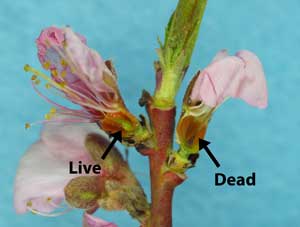 |
| Figure 2: Fantasia nectarine buds, cut longitudinally to show the pistil, one live and one dead (photo by HJLarsen). |
Then cut and examine the buds for brown to black discoloration of the fruit pistil (young fruit within the flower, Figure 2). Assessing dead/injured
flower pistils and ovaries in 100 buds provides a good estimate of percentage crop loss. A general rule of thumb is that sweet cherries need about 50 percent of the buds produced the previous summer to make it to harvest in order to have a full crop; all the other tree fruits (apple, pear, apricot, peach, nectarine, and plum) need only about 10 percent for a full crop.
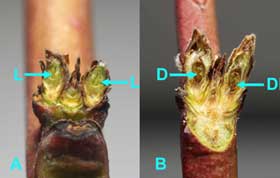 |
| Figure 3: BerendaSun peach buds (first swell stage) cut vertically to show pistils. A. Both buds alive. B. Both buds dead (Photo by H.J.Larsen.) |
The cutting process requires a sharp razor blade; single edge blades work well because they are stiffer and easier to control for cutting. They are quite inexpensive and can be discarded when the cutting edge becomes dull or damaged. Remove debris and sap on the blade by rubbing the edge carefully with water.
Apricot, peach, and nectarine buds are easiest to cut by starting at the base of the bud (or flower) and cutting on a vertical diagonal. Buds in early stages of development often have the cut expose the stigma and style part of the pistil and make assessment fairly easy (Figure 3). Buds in later stages of development (near bloom) often are best evaluated by simply cutting the petal corolla vertically to expose the entire pistil to view for evaluation. Buds killed within the past day or two will have pistils that are the same size or only slightly smaller than live pistils while buds killed several weeks previously will have a very small pistil with a much darker discoloration (Figure 4). Pistils often develop discoloration within hours at room temperature after being killed; apricot pistils often turn a blackish brown (Figure 5).
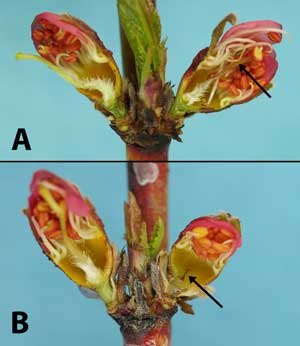 |
| Figure 4: BerendaSun peach buds (first pink stage) cut vertically to expose the pistil for freeze injury evaluation. Arrows: damaged or dead pistil (right side each photo). A. Right bud shows pistil damaged by freeze the prior night; note brownish discoloration of pistil. B. Right bud shows pistil killed by freeze two to three weeks prior to evaluation. Note smaller size and darker brown color of the older freeze-killed pistil in B than in A. (Photos by H.J. Larsen.) |
Once bloom is completed and the young fruit is present, one needs to make a transverse (horizontal) cut through the fruit about 1/3 of the distance from the stem end to the stylar end in order to cut through the embryo structure called the funiculus, an “umbilical cord-like” connection to the exterior fruit tissue (Figure 6). A vertical cut can also be used if one cuts through the suture (fruit crease) to the back of the fruit, but that often is more difficult. Damage to the funiculus often results in the embryo within the young fruit either dying (and the fruit dropping in mid-June) or stopping development with the fruit never sizing beyond the size of a walnut. This can be seen at harvest in years with frost around the time of shuck-fall for peach and nectarine.
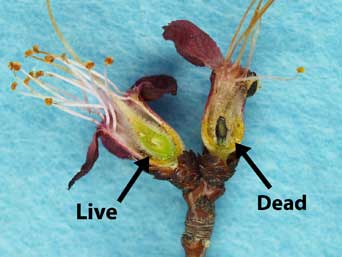 |
| Figure 5: Apricot buds (full bloom stage) cut vertically to expose the pistil for freeze damage evaluation. Note the blackened pistil on the right, killed by the prior night freeze (Photo by H.J. Larsen.) |
Sweet cherry, plum, apple, and pear buds are multiple-flower buds (more than one flower inside each bud). Plums typically have two flowers or buds and cherries usually have two to five flowers or buds (Figure 7), and apples and pears typically have six or more flowers or buds. But both plums and cherries can have only a single flower within a bud if some flower initials are killed by winter injury. A horizontal cut through these multiple-flower buds will cut through several of the flowers they contain. However, because the flowers within these buds often have differing timing for bloom, it is difficult to see all the flowers at one time. Often the most advanced flower will be the highest (furthest from the base of the bud) and the least advanced flower be the lowest (closest to the base of the bud). The earlier in bud development that the evaluation is done, the greater the possibility of seeing all the flowers within the bud; the closer to bloom, the less likely the possibility of seeing the pistils of all the flowers within the bud simultaneously with a single cut. At or near bloom, one needs to use more angled vertical cuts to reveal the pistils (Figure 8).
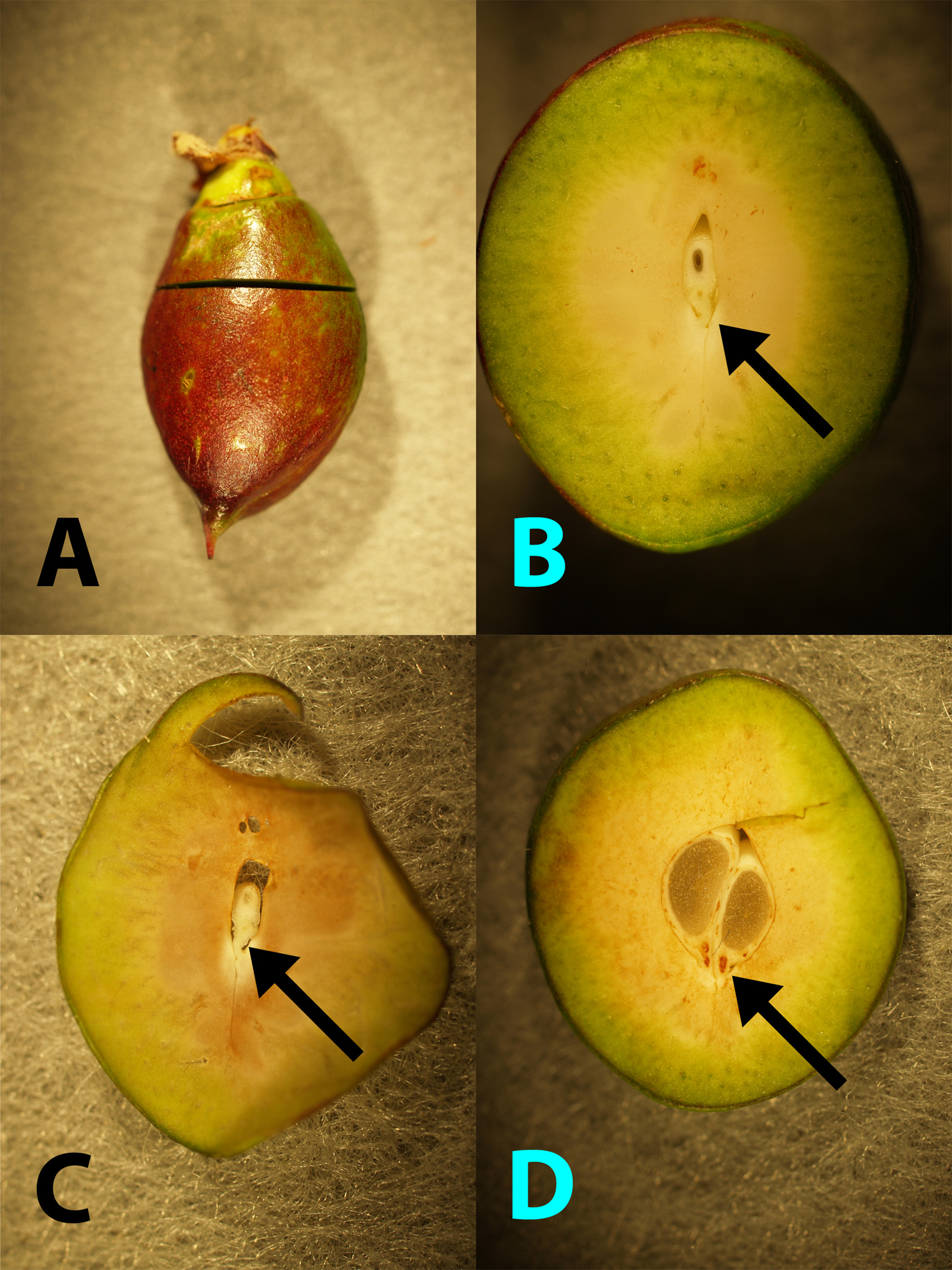 |
| Figure 6: Young nectarine cut to show embryo attachment (funiculus, arrows) to the fruit tissue. A. Cut orientation and location. B. Young embryo with undamaged funiculus. C. Thin section to emphasize embryo and undamaged funiculus). D. Twin embryos with damage within each funiculus; note the brown discoloration. (Photos by H.J. Larsen.) |
Apple and pear buds, like plum, tend to have differing timing for opening of the flowers within the fruit bud. In apples, the “king bloom” is the first to open and leads the other flowers within the bud in development. It is the center flower, typically with five “side bloom” flowers forming a ring around it (Figure 9: b). Because it leads the side bloom flowers in developing, it typically will be positioned toward the top of the bud when one makes a horizontal cut through the flower bud. When flower structures are damaged by frost or freezing temperatures, injured tissues of the style and ovary will become darkened (blackish brown with time) through formation of phenolic compounds in response to injury (Figure 9: a). Cross-sectional cuts through the flower will reveal these darkened flower structures for counting purposes if one makes sequential cuts beginning at the upper top of the bud and proceeding toward the base of the bud. Because the style (the central portion of the pistil) is so much longer than the stigma (top portion of the pistil), it is typically the structure seen in the cross-sectional cuts through the upper portion of the flower where the petals are found (Figure 9: c and d.) Browning of this structure after a frost event is a good indication that the flower has been killed and will not become a successful fruit.
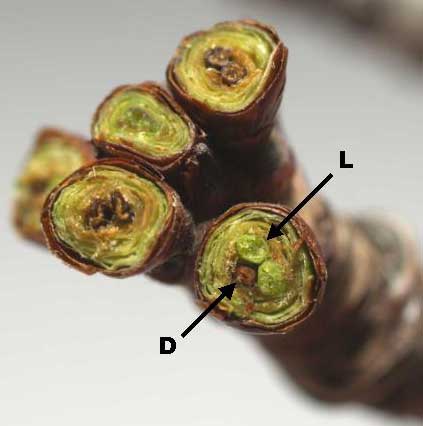 |
| Figure 7: Bing sweet cherry buds (multiple-flower buds) cut horizontally across the bud for flower viability evaluation. Arrows: D = dead flowers (dark brown color), L = live flower (Photo by H.J. Larsen.) |
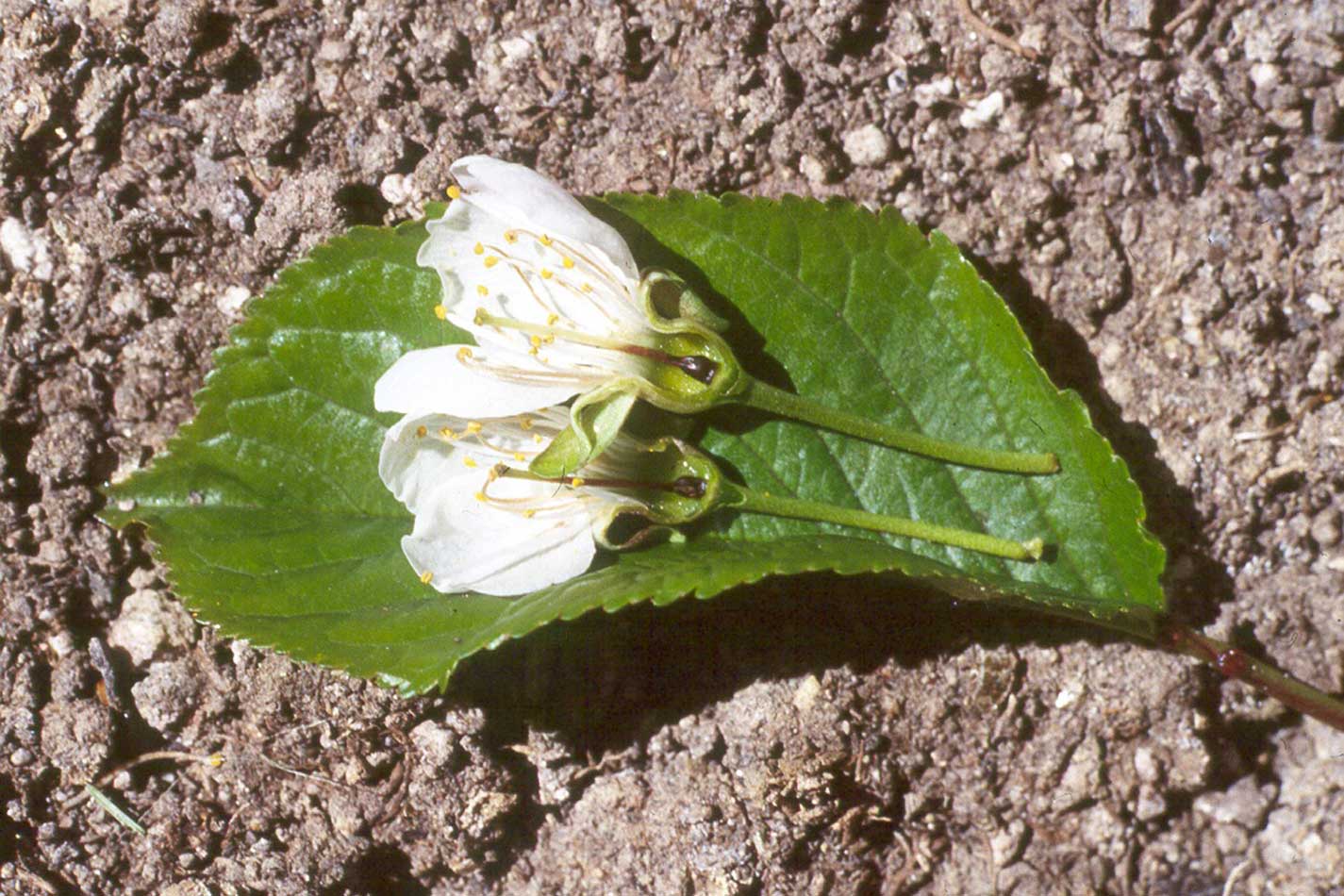 |
| Figure 8: Sweet cherry flowers killed by frost at bloom, cut vertically to expose the blackened pistil. (Photo by H.J. Larsen.) |
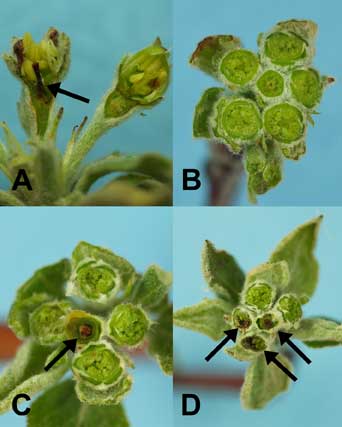 |
| Figure 9: Apple buds cut to show cold injury damage; arrows show killed pistil tissues. A.Longitudinal section (left flower killed). B – D: Cross-sections of flower buds. B. Six live flowers (King bloom in center); C: King bloom pistil killed, side blooms still alive; D: King bloom and two side blooms killed, two top side blooms alive. |
In pears, the spread in flower stage of development is even greater as they approach bloom. However, the flowers in pear tend to develop from the base of the shoot toward the top of this shoot (Figure 10). This makes cold injury damage evaluation even more dependent of multiple cuts through the developing buds. As with apple, damage to and discoloration of the stylar tissue within the blossom following exposure to freezing temperatures often is associated with death of the flower (Figure 10: b – d). Pear has a tendency to develop late flowers at the tips of shoots (these are commonly termed “rat-tail bloom”). These late flowers can escape earlier frost damage and set fruit, but the fruit from such usually is substantially smaller and lower in quality.
Very late frost events after petal-fall can cause injury to young fruit tissues and impact fruit quality and appearance (Figure: 11). Sweet cherry fruit exposed to cold can be killed outright (Figure11: a). Injury to young peach fruit can result in fruit that never sizes beyond the size of a walnut. This can readily be seen as non-damaged fruit approaches ripeness (Figure 11: b). Young injured apple and pear fruit often have the surface cells and tissues killed and develop a pronounced scabby pattern on the fruit surface that is termed “frost ring” (Figure11: c and d). Such affected fruit, although edible, are not salable and often are removed by hand thinning if possible.
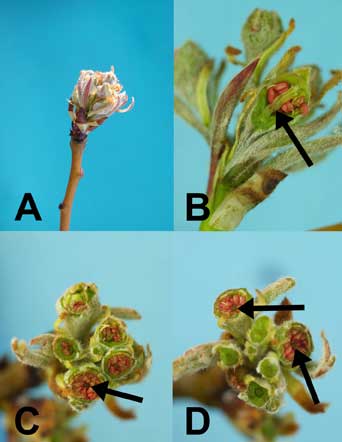 |
| Figure 10: Pear buds. A. Pear bud showing the multiple-flowers bud type. B. Longitudinal section showing pistil compound style (arrow points to stylar bundle leading to fused ovary receptacle). C & D. Cross-section cut through the multiple flowers; C is higher level cut, D is next cut lower; arrows in C & D point to stylar clusters with tissue browning that could indicate cold damage and death of the stylar tissues. (Photos by H.J. Larsen.) |
Researchers working on cryopreservation of fruit buds have noted that buds that are frozen before they have cold acclimated (i.e., Sept./Oct./early Nov.) often had oxidative browning of the tissue leading to them that will become the vascular traces to the buds. Buds with such damage could not be successfully grafted for subsequent germplasm recovery. This type of injury can occur from a late fall and early winter freeze, especially where mild temperatures precede a freeze event, but not after mid-winter when these tissues are very cold hardy. Buds damaged in this manner may open, but subsequently fall off in late spring to early summer as water stress becomes an issue (C.E. Stushnoff, pers. com). Consequently, fruit bud protection efforts against cold injury may need to include late fall and early winter, especially if a rapid drop to potentially damaging temperatures is forecasted to follow prolonged warm weather that slows cold acclimation by the buds.
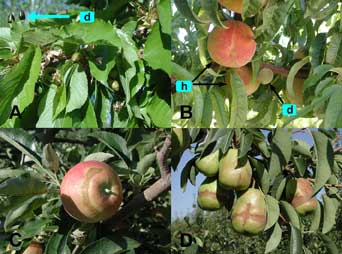 |
| Figure 11: Late frost injury to young fruit. A. Sweet cherry: d = killed young cherry fruit. B.Peach: h = healthy, maturing fruit; d = damaged, non-maturing fruit. C. Apple with frost
ring. D. Pears with frost ring. (Photos by H.J. Larsen.) |
Finally, bud viability can be assessed without need for a magnifying lens or stereoscope after the buds complete their chill requirement by forcing buds to bloom indoors. Cut some shoots with flower buds on them, place them promptly into water in a can or a jar or vase and keep them at room temperature for several weeks. Re-cut the shoot ends every five days or so because the vascular tissue tends to plug up in that length of time. Most tree fruits accumulate around 400 Growing Degree Hours (GDH) per day when held at 70F, and need between 4,000 and 7,000 GDH to reach bloom. Thus, viable buds should bloom within 10 to 16 days when incubated in water at 70F. Apricots, peaches, and plums often complete chill requirements between late December and mid-January in western Colorado; cherries, apples, and pears often complete their chill requirements between late January and late February.
1H. J. Larsen, Colorado State University Extension fruit crops pathology and diseases specialist and associate professor; horticulture and landscape architecture. (retired) 8/2010.
Colorado State University, U.S. Department of Agriculture, and Colorado
counties cooperating. CSU Extension programs are available to all without
discrimination. No endorsement of products mentioned is intended nor is
criticism implied of products not mentioned.
Go to top of this page.





